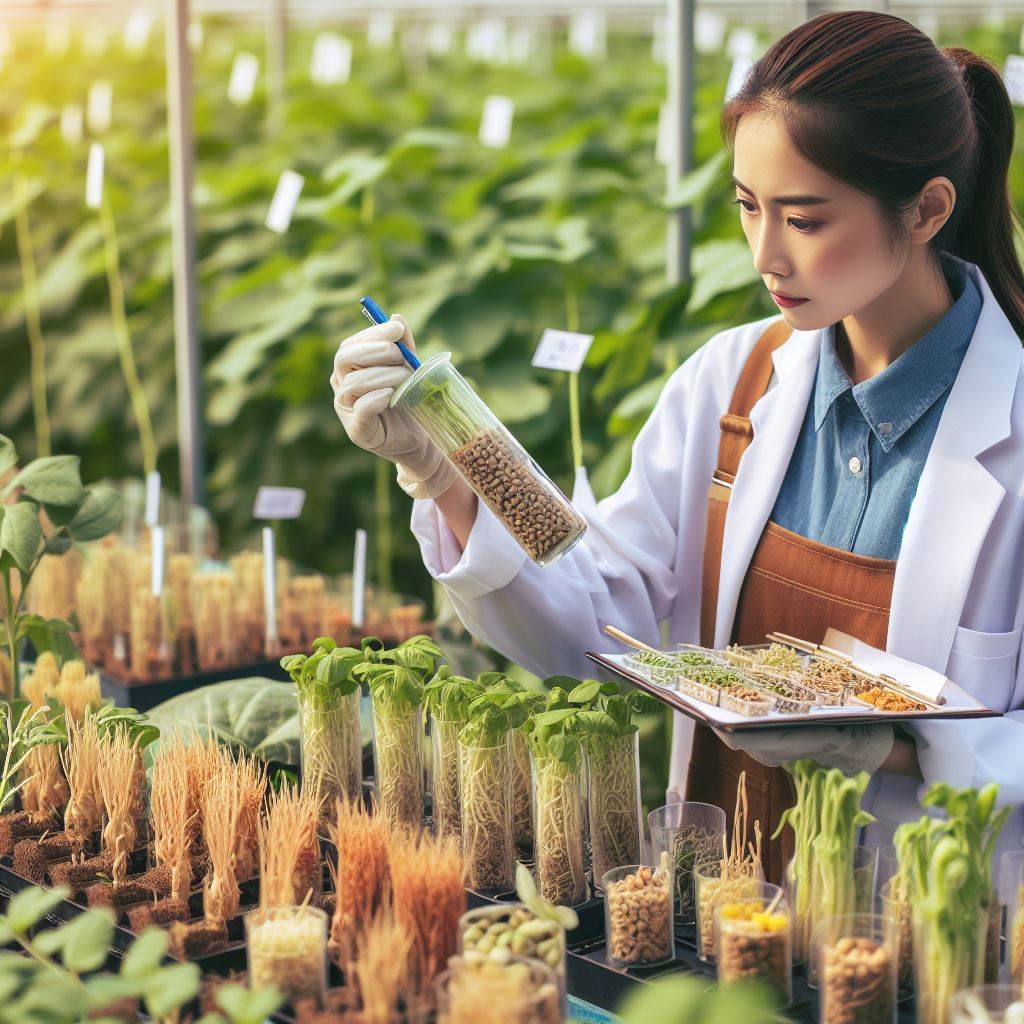Introduction
Definition of adaptive farming
Adaptive farming refers to the practice of adjusting agricultural methods and strategies to cope with the challenges posed by climate change.
It involves adopting flexible techniques, such as crop diversification, water management, and soil conservation, to mitigate risks and enhance resilience against climate variability.
By continuously monitoring and adapting to evolving circumstances, adaptive farming promotes sustainable and productive agricultural systems.
Importance of addressing climate change in agriculture
Addressing climate change is crucial for ensuring food security and sustaining agricultural productivity in the face of changing climatic conditions.
Rising temperatures, erratic weather patterns, and shifting growing seasons pose significant challenges to crop yields and livelihoods.
Implementing sustainable practices, resilient crop varieties, and adaptation strategies are critical for ensuring the long-term viability and resilience of agricultural systems worldwide.
Understanding Climate Change
Overview of Climate Change and its Causes
Climate change refers to long-term shifts in weather patterns and average temperatures caused by human activities, primarily the emission of greenhouse gases.
These gases, such as carbon dioxide and methane, trap heat in the Earth’s atmosphere, leading to global warming.
The main contributors to climate change include burning fossil fuels for energy, deforestation, industrial processes, and agricultural practices.
These activities release significant amounts of greenhouse gases into the atmosphere, intensifying the greenhouse effect and altering the climate.
Impacts of Climate Change on Agriculture
Climate change poses numerous challenges to the agricultural sector, affecting both crop production and livestock farming.
Rising temperatures can shorten growing seasons and reduce crop yields, particularly in areas with water stress.
Extreme weather events like droughts, floods, and heatwaves become more frequent and intense, posing threats to agricultural productivity and food security.
Changing precipitation patterns can also disrupt planting schedules and increase the incidence of pests and diseases.
Livestock farming is also vulnerable to climate change, with heat stress affecting animal health and productivity.
Transform Your Agribusiness
Unlock your farm's potential with expert advice tailored to your needs. Get actionable steps that drive real results.
Get StartedChanges in pasture quality and availability can limit animal grazing, leading to increased feed costs and reduced herd sizes.
Regional Variations in Climate Change Effects
The impacts of climate change on agriculture vary across regions, depending on local climatic conditions and vulnerability.
Some regions may experience more severe effects, while others might have adaptive capacities to mitigate the risks.
In tropical areas, for example, higher temperatures and increased rainfall intensity can lead to soil erosion and reduced soil fertility.
Coastal regions face the additional challenge of rising sea levels, which can contaminate freshwater sources and erode farmland.
In arid and semi-arid regions, climate change exacerbates water scarcity, making irrigation more essential but also more challenging.
Droughts can also increase desertification, threatening the livelihoods of farmers and pastoralists who rely on marginal lands.
Mountainous areas are particularly vulnerable to climate change, with rising temperatures accelerating the melting of snow and glaciers.
This reduces water availability for agriculture and affects hydroelectric power generation downstream.
Adaptive Farming in the Face of Climate Change
To cope with the challenges of a changing climate, farmers and agricultural researchers are exploring adaptive farming strategies.
These strategies aim to enhance resilience, reduce greenhouse gas emissions, and maintain or improve agricultural productivity.
Some adaptive practices include:
Crop diversification
Planting a variety of crops can buffer against climate variability and reduce the risk of yield loss.
Diverse crop rotations can also improve soil health and nutrient cycling.
Water management
Implementing efficient irrigation systems, rainwater harvesting, and water conservation techniques help farmers adapt to changing precipitation patterns and water scarcity.
Agroforestry
Integrating trees and shrubs into farming systems provides multiple benefits, such as improving soil fertility, enhancing biodiversity, and providing shade and windbreaks.
Conservation agriculture
This approach emphasizes minimal tilling, permanent soil cover, and crop rotations to improve soil structure, water retention, and carbon sequestration.
Improved livestock management
Utilizing shade structures, cooling techniques, and selecting heat-tolerant breeds can help mitigate heat stress in livestock.
Climate information services
Access to accurate and timely climate information allows farmers to make informed decisions about planting, irrigation, and pest management.
Sustainable intensification
Balancing the intensification of agricultural production with sustainable practices helps meet increasing food demand while minimizing environmental impacts.
In general, understanding climate change and its impacts on agriculture is crucial for developing adaptive farming strategies.
By implementing these strategies, farmers can mitigate risks, enhance resilience, and contribute to sustainable food production in a changing climate.
Challenges Faced by Farmers
Changes in precipitation patterns
Farmers experience unpredictable rainfall, with periods of droughts and intense rainfall affecting crop production.
Water scarcity becomes a major challenge, making it difficult for farmers to irrigate their crops effectively.
Showcase Your Farming Business
Publish your professional farming services profile on our blog for a one-time fee of $200 and reach a dedicated audience of farmers and agribusiness owners.
Publish Your ProfileChanging precipitation patterns require farmers to adjust their planting schedules and irrigation systems accordingly.
Excessive rainfall can lead to soil erosion and nutrient leaching, negatively impacting soil quality and crop growth.
Implementing water conservation measures becomes essential for farmers to adapt to these changing precipitation patterns.
Rising temperatures and extreme weather events
Farmers face the challenge of increasing temperatures, which affect crop development and yield.
Extreme heatwaves can lead to heat stress in plants, reducing their ability to produce and reproduce.
Warmer temperatures also accelerate the life cycle of pests and diseases, leading to higher infestations.
Adopting heat-tolerant crop varieties and employing shade systems can help mitigate the effects of rising temperatures.
Farmers must also prepare for extreme weather events, such as hurricanes and floods, which can cause severe damage to crops and infrastructure.
Increased pests and diseases
Climate change creates an environment conducive to the proliferation of pests and diseases.
Rising temperatures allow pests and diseases to survive and spread into new regions previously unsuitable for them.
Pests like insects and rodents become more resilient, requiring farmers to implement integrated pest management strategies.
Evolving diseases pose a challenge as existing treatment methods may become less effective.
Regular monitoring, implementing biosecurity measures, and using resistant crop varieties are crucial for pest and disease management.
Changing growing seasons
Climate change alters the timing and duration of growing seasons, disrupting traditional farming practices.
Warmer winters and shorter frost periods can affect crop chilling requirements and plant dormancy.
Delayed or inconsistent seasons affect crop phenology, making it difficult for farmers to determine the best planting and harvesting times.
Developing crop calendars and embracing innovative techniques can help farmers adapt to changing growing seasons.
Flexible cropping systems and diversification of crops enable farmers to adjust to the variability of growing seasons.
Adaptive farming in a changing climate comes with various challenges for farmers.
Changes in precipitation patterns bring unpredictable rainfall, water scarcity, and soil erosion issues.
Rising temperatures and extreme weather events affect crop development, heat stress, and pest infestations. Increased pests and diseases necessitate integrated pest management strategies and the use of resistant crop varieties.
Changing growing seasons disrupt traditional practices, requiring farmers to adjust their planting schedules and embrace innovative techniques.
However, with proper adaptation strategies and agricultural advancements, farmers can overcome these challenges and ensure sustainable food production amidst a changing climate.
Read: Climate Change & Pest Pressure on Soil
Adaptive Farming Practices
Crop Diversification
Benefits of diversification
Crop diversification brings numerous benefits to farmers facing the challenges of a changing climate.
By growing different types of crops, farmers reduce their risk of crop failure.
Diversification increases resilience to extreme weather events such as droughts, floods, and heatwaves.
Moreover, it improves soil health by reducing pest and disease pressure.
Different crops have varying nutrient requirements, and by rotating crops, farmers can maintain soil fertility while reducing the need for synthetic fertilizers.
Additionally, crop diversification promotes biodiversity by providing habitats for beneficial insects and wildlife.
Examples of diversification strategies
Farmers can employ various strategies for crop diversification.
One approach is to grow different crops within a single farming year, known as intercropping.
For instance, planting legumes alongside cereals can enhance nitrogen fixation while providing additional income from legume sales.
Another strategy is relay cropping, where a second crop is sown before the first is harvested.
This practice optimizes the use of limited land and extends the growing season.
Additionally, farmers can choose to cultivate climate-resilient crops that are better adapted to changing climatic conditions, such as drought-tolerant varieties or those resistant to pests and diseases.
Soil Conservation and Management
Importance of healthy soils
Healthy soils are the foundation of successful farming and vital for adaptive agriculture.
They provide the necessary nutrients for plants to grow, retain water, and support beneficial soil microorganisms.
Healthy soils also contribute to carbon sequestration, mitigating climate change by storing carbon dioxide.
Furthermore, well-managed soils are more resistant to erosion, which is increasingly prevalent due to extreme rainfall events.
Showcase Your Farming Business
Publish your professional farming services profile on our blog for a one-time fee of $200 and reach a dedicated audience of farmers and agribusiness owners.
Publish Your ProfileBy maintaining soil health, farmers can minimize nutrient runoff and preserve valuable topsoil, ensuring the long-term sustainability of their farms.
Techniques for maintaining soil health
There are several techniques that farmers can employ to maintain soil health.
One essential practice is the use of cover crops, which are planted during fallow periods to protect the soil from erosion and improve organic matter content.
Cover crops also promote soil structure, water infiltration, and microbial activity.
Conservation tillage, such as no-till or reduced tillage, helps prevent soil erosion and compaction while preserving soil moisture.
Avoiding excessive use of agrochemicals like pesticides and fertilizers is also crucial for maintaining soil health, as these can negatively impact beneficial soil organisms.
Water Management
Efficient irrigation methods
Water management plays a vital role in adaptive farming practices, particularly in regions prone to water scarcity.
Adopting efficient irrigation methods helps minimize water wastage and optimize water use.
Drip irrigation, for example, delivers water directly to plant roots, reducing evaporation losses and increasing water use efficiency.
Similarly, precision irrigation systems utilize technology to precisely monitor soil moisture levels, ensuring irrigation only occurs when necessary.
These methods can significantly conserve water resources while sustaining crop growth even in the face of water shortages.
Rainwater harvesting techniques
In areas with limited access to irrigation water, rainwater harvesting techniques can be utilized.
Farmers can construct rainwater ponds or tanks to capture and store rainwater during the rainy seasons.
This stored water can then be used during dry spells to irrigate crops or provide drinking water for livestock.
Additionally, contour plowing and terracing techniques help prevent rainwater runoff and allow better infiltration into the soil.
By managing and utilizing rainwater effectively, farmers can overcome water scarcity challenges and ensure the sustainability of their farming operations.
Pest and Disease Management
Integrated pest management practices
Adaptive farming requires effective pest and disease management strategies that minimize the use of chemical pesticides.
Integrated pest management (IPM) integrates various practices such as crop rotation, biological control, and cultural practices to control pests and diseases.
Crop rotation disrupts pest life cycles by alternating different crops in a field, reducing pest populations naturally.
Biological control methods involve introducing beneficial insects or organisms that prey on pests, providing a natural and sustainable approach to pest control.
Cultural practices like maintaining proper plant spacing, removing plant residues, and implementing good hygiene practices contribute to reducing pest and disease incidents.
Biological control methods
Biological control methods offer alternatives to chemical pesticides.
For example, farmers can release natural predators like ladybugs or parasitic wasps that feed on pests, effectively controlling their populations.
Similarly, the use of pheromone traps can disrupt mating patterns of pests, reducing their reproduction rates.
Developing and implementing disease-resistant crop varieties through traditional breeding or genetic engineering is also a valuable approach.
By reducing reliance on chemical pesticides, farmers can protect their crops while minimizing environmental impacts and maintaining soil and ecosystem health.
In essence, adaptive farming practices such as crop diversification, soil conservation, water management, and pest and disease management are essential strategies for farmers to cope with a changing climate.
By implementing these practices, farmers can enhance their resilience, protect the environment, and ensure sustainable agricultural production in the face of climate challenges.
Read: Soil Health: Balancing pH and Climate

Technological Advances in Adaptive Farming
In the face of a changing climate, farmers across the globe are embracing adaptive farming practices to ensure food security and sustainable agricultural production.
These practices are crucial in mitigating the effects of climate change on crops and livestock.
While traditional farming methods have long been dependent on weather patterns and experience, technological advancements have revolutionized the agricultural landscape.
This section will explore two essential technological advances in adaptive farming: precision agriculture and climate-resilient crop varieties.
Precision agriculture
Precision agriculture, also known as satellite farming or site-specific crop management, involves the use of data and sensors to make more informed and precise decisions regarding farming practices.
Farmers collect data on soil fertility, moisture levels, weather patterns, and crop conditions using various technologies.
These data are then analyzed to optimize resource allocation, minimize inputs, and maximize yields.
By leveraging precision agriculture techniques, farmers can tailor their actions to specific areas of their fields, maximizing efficiency and minimizing waste.
The adoption of precision agriculture technologies has proved beneficial in several ways.
For example, drones equipped with multispectral cameras can capture high-resolution images of fields, providing valuable insights into crop health and identifying potential issues such as nutrient deficiencies or pest infestations.
Satellite imagery allows farmers to monitor large areas of land, enabling early detection of changes in soil moisture levels and predicting crop water demand.
Showcase Your Farming Business
Publish your professional farming services profile on our blog for a one-time fee of $200 and reach a dedicated audience of farmers and agribusiness owners.
Publish Your ProfileSoil moisture sensors provide real-time information on soil conditions, helping farmers decide when and how much to irrigate, thus optimizing water use.
Climate-resilient crop varieties
Another significant aspect of adaptive farming is the cultivation of climate-resilient crop varieties.
As climate change brings more frequent extreme weather events, such as prolonged droughts or intense rainfall, traditional crop varieties might struggle to adapt.
Breeding resistant crops that can withstand these new challenges becomes vital for sustaining agricultural productivity.
Scientists and breeders focus on developing crop varieties with traits like heat and drought tolerance, disease resistance, and improved water and nutrient-use efficiency.
Genetically modified organisms (GMOs) play a crucial role in adaptive agriculture. GMOs have been genetically engineered to exhibit certain desirable traits, such as resistance to pests, diseases, or herbicides.
This genetic modification helps crops withstand environmental stressors brought about by climate change.
For example, drought-tolerant GMOs can continue growing and producing yield even in water-limited conditions.
By incorporating GMOs into their farming practices, farmers can enhance crop adaptation and resilience, ensuring stable food production despite changing climatic conditions.
In summary, technological advances, such as precision agriculture and climate-resilient crop varieties, have empowered farmers to adapt to the challenges posed by a changing climate.
Precision agriculture harnesses the power of data and sensors to optimize resource allocation and maximize yields, while climate-resilient crop varieties, including GMOs, enhance the ability of crops to withstand climate stressors.
These advancements are crucial for ensuring food security and maintaining sustainable agricultural practices in the face of a rapidly changing climate.
Read: Fertilization Strategies in a Hotter World
Government Support and Policies
Importance of government involvement
Government plays a crucial role in supporting and promoting adaptive farming in a changing climate.
It is essential for governments to recognize the challenges faced by farmers due to climate change.
Government involvement can provide the necessary resources, expertise, and coordination needed for successful adaptation.
Financial assistance for adaptive farming practices
Governments can offer financial assistance, such as grants or subsidies, to farmers engaged in adaptive farming practices.
These financial incentives can help farmers implement climate-resilient strategies and invest in advanced technologies.
Financial support can also help alleviate any additional costs incurred by farmers due to climate change impacts.
Implementation of climate-smart agriculture policies
Governments should formulate and implement climate-smart agriculture policies to address the challenges posed by climate change.
Such policies should emphasize sustainable practices, resource conservation, and resilience-building measures.
Climate-smart agriculture policies can promote the adoption of climate-resilient crop varieties and improved water management techniques.
These policies should also encourage the use of precision agriculture techniques, such as remote sensing and data-driven decision-making.
Benefits of government support and policies in adaptive farming:
- Increased productivity: Government support can help farmers adopt innovative technologies and practices, leading to improved yields.
- Risk reduction: Adequate funding and policies can help farmers mitigate risks associated with climate change, ensuring their livelihoods.
- Environmental sustainability: Climate-smart agriculture practices can protect natural resources and reduce greenhouse gas emissions.
- Economic growth: Government involvement can contribute to the growth and development of the agricultural sector, stimulating economic activity.
- Food security: Climate-resilient farming practices enabled by government support ensure consistent food production, even in challenging climates.
- Knowledge sharing: Governments can facilitate knowledge exchange between farmers, researchers, and experts, promoting innovation and adaptation.
Examples of successful government initiatives
The Climate Resilient Agriculture Program in Country X provides financial assistance to farmers for adopting climate-smart practices.
Country Y’s government offers subsidies for the purchase of climate-resilient crop varieties and precision agriculture technologies.
The National Farm Resilience Program in Country Z provides training and technical support to farmers for climate adaptation.
Overall, government involvement is crucial for supporting adaptive farming practices in a changing climate.
Financial assistance and implementation of climate-smart agriculture policies are vital for farmers’ resilience and the sustainability of the agricultural sector.
Government support not only ensures food security and economic growth but also contributes to environmental sustainability and knowledge sharing within the farming community.
Read: Heat Stress on Soil: Protecting Our Farms
Case Studies
Successful examples of adaptive farming projects
Community-based adaptation initiatives
A small rural community in a developing country implemented adaptive farming practices to overcome climate challenges.
They formed a cooperative to pool resources and expertise.
The community members diversify agricultural activities
Farmer-led adaptive strategies
In a region with unpredictable rainfall, farmers adopted innovative techniques to adapt to changing weather patterns.
They experimented with drought-tolerant crop varieties, water conservation methods, and agroforestry.
Lessons learned from these case studies
The successful examples of adaptive farming projects offer valuable insights for sustainable agriculture:
- Community participation: Involving the local community in decision-making processes and implementing community-based projects enhances resilience and ownership.
- Knowledge exchange: Sharing knowledge and experiences among farmers, scientists, and extension services boosts adaptive farming practices.
- Flexibility: Farmers need to be open to trying new techniques and adapting their strategies according to changing climate patterns.
- Local context: Understanding the local climate, soil conditions, and socio-economic factors is crucial for designing effective adaptive farming projects.
- Diversification: Integrating multiple agricultural activities, such as crop rotation, livestock rearing, and agroforestry, can reduce vulnerability to climate risks.
- Technology and innovation: Encouraging the use of climate-smart technologies and promoting innovation can help farmers cope with climate change challenges.
- Capacity building: Providing training and education on adaptive farming techniques equips farmers with the necessary skills and knowledge to implement successful strategies.
- Policy support: Governments and organizations should create supportive policies and provide financial incentives to encourage farmers to adopt adaptive farming practices.
- Monitoring and evaluation: Regular monitoring and evaluation of projects can help identify successes, challenges, and areas for improvement.
By analyzing successful case studies, it becomes evident that adaptive farming strategies can mitigate the negative impacts of climate change on agriculture.
These case studies provide inspiration for farmers, policymakers, and organizations to embrace adaptive farming approaches and work towards a sustainable agricultural future.
Conclusion
Recap of the importance of adaptive farming
Throughout this blog post, we have highlighted the crucial role of adaptive farming in mitigating the challenges posed by a changing climate.
Encouragement for farmers to adopt adaptive practices
It is essential for farmers to embrace innovative techniques and technologies to ensure the long-term sustainability of their farms and livelihoods.
Showcase Your Farming Business
Publish your professional farming services profile on our blog for a one-time fee of $200 and reach a dedicated audience of farmers and agribusiness owners.
Publish Your ProfileCall to action for supporting sustainable agriculture in a changing climate
We must all come together to support and promote sustainable agriculture practices that can withstand the impacts of climate change.
Governments, organizations, and individuals need to provide the necessary resources, funding, and knowledge to empower farmers in this transition.
By championing adaptive farming, we can improve food security, minimize environmental degradation, and enhance the resilience of farming communities.
Together, let’s make a difference in the face of this changing climate by implementing and supporting adaptive farming practices.




